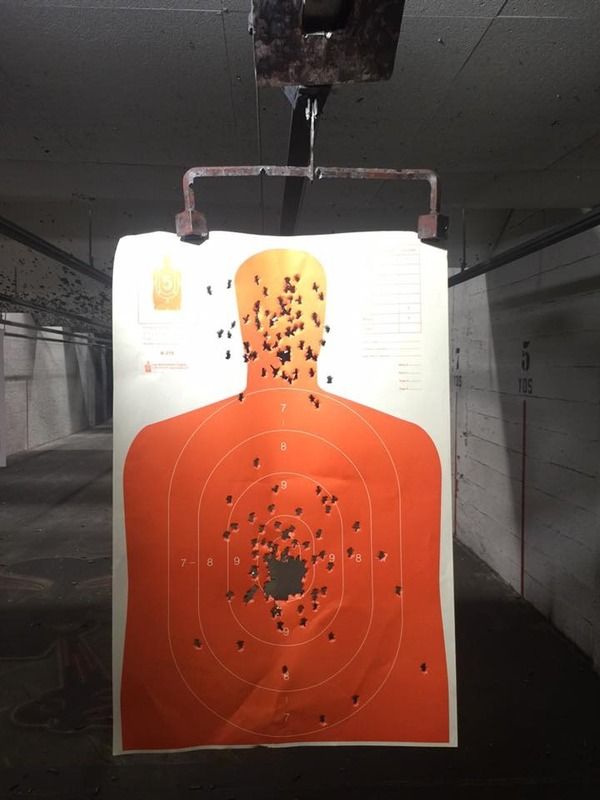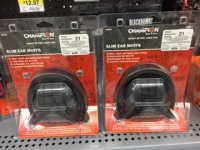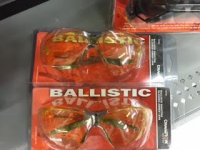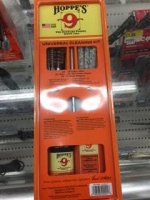I bought this stuff today. Is that universal cleaner good for cleaning it? I didnt clean the gun yesterday after shooting 100 rounds through it. Got my own eye n ear protection and an extra pair if I want to take someone with me.
You are using an out of date browser. It may not display this or other websites correctly.
You should upgrade or use an alternative browser.
You should upgrade or use an alternative browser.
So I bought a 9mm XDm 4.5". No idea how to use it
- Thread starter desibaba
- Start date
marine6680
New member
Double hearing protection is a must at an indoor range. Enclosed spaces and hard surfaces make for loud echoes.
As far as your shooting... For someone who just recently was declaring their complete ignorance of how to handle, use, and maintain a firearm... You are producing groups (assuming at a range between 5-10yds) that would be effective for self defense...
I see people who claim to shoot regularly that have groups that look like they threw the bullies at the paper by the handful, with holes spread over the entire target.
The two biggest things that I see that cause shooters to have poor accuracy or from progressing to better accuracy are trigger control issues and flinch/recoil anticipation.
Both issues have a simple solution, but first I will tell you what they are.
Trigger control is the ability to give a smooth and consistent pull of the trigger, one that does not disrupt your aim due to inefficient movement that affects your entire hand.
This is because of the sympathetic response, it is what makes it hard to move just one finger without moving at least one other.
Flinch/recoil anticipation is the tendency for some/many to tense up or flinch often subconsciously in reaction to, or in anticipation of, recoil.
It's easy to test for. Have a second person load your magazine, and have them put a dummy round in the mag randomly. When you use the mag, you will not know which bullet is the dummy round and when you pull the trigger with the dummy round chambered, you will notice if you get tense or jerk, as the pistol will move and your sights will go out of alignment.
And if you test yourself and find you do not flinch now, does not mean you will not develop it in the future, so check every now and then. Especially if you have accuracy woes.
Get in the mindset that "recoil happens", live with it, don't fight it. Good grip and stance are the tools to keep recoil controlled.
The best tool to fight these problems is dry firing.
Meaning clear the gun, remove any ammunition from the area, and practice pulling the trigger while looking down the sights.
Do this by pointing the firearm in a safe direction... Remember all guns are always loaded, even when they are not. And you want the room to be well lit and the wall needs to be contrasting in color so you can see you sights very well.
Focus on your front sight, which is the most important part of sight picture and sight alignment... The rear sight and target may be a bit out of focus, but if you focus on the front sight properly, your brain can compensate.
Now while aiming down the sights, pull the trigger in a smooth and controlled manner. Do not rush the pull, focus on being controlled and smooth, and speed will come with practice and skill.
Did your front sight move when the trigger broke? Yes? Then you didn't pull smooth and even... Try again. Did they move? No? Keep doing it like that.
While this practice seems obvious as to how it improves trigger control... But it does help flinch/anticipation because it teaches you to focus on aiming and trigger control as being forefront of the experience, and if you apply the same technique when you are using live ammunition, you will notice that you forget to worry about recoil... Even subconsciously.
I do this any time I am near my safe and have a few free moments. Just a few practice pulls, then I go about my day. Every couple days or so, or more.
There are insurance plans out there that you can get to cover the cost of legal fees in the event you use a firearm for self defense. I do not believe they are very expensive.
While your location can play a big role in how you are treated after a defense encounter, less fun friendly areas are worse by default often times, circumstances may play out and it become a political topic and then court cases get started that might not have otherwise happened.
It is just something we must prepare for if we choose to use a firearm for defense in addition to the general hobby aspects.
Most importantly... Keep practicing and have fun.
As far as your shooting... For someone who just recently was declaring their complete ignorance of how to handle, use, and maintain a firearm... You are producing groups (assuming at a range between 5-10yds) that would be effective for self defense...
I see people who claim to shoot regularly that have groups that look like they threw the bullies at the paper by the handful, with holes spread over the entire target.
The two biggest things that I see that cause shooters to have poor accuracy or from progressing to better accuracy are trigger control issues and flinch/recoil anticipation.
Both issues have a simple solution, but first I will tell you what they are.
Trigger control is the ability to give a smooth and consistent pull of the trigger, one that does not disrupt your aim due to inefficient movement that affects your entire hand.
This is because of the sympathetic response, it is what makes it hard to move just one finger without moving at least one other.
Flinch/recoil anticipation is the tendency for some/many to tense up or flinch often subconsciously in reaction to, or in anticipation of, recoil.
It's easy to test for. Have a second person load your magazine, and have them put a dummy round in the mag randomly. When you use the mag, you will not know which bullet is the dummy round and when you pull the trigger with the dummy round chambered, you will notice if you get tense or jerk, as the pistol will move and your sights will go out of alignment.
And if you test yourself and find you do not flinch now, does not mean you will not develop it in the future, so check every now and then. Especially if you have accuracy woes.
Get in the mindset that "recoil happens", live with it, don't fight it. Good grip and stance are the tools to keep recoil controlled.
The best tool to fight these problems is dry firing.
Meaning clear the gun, remove any ammunition from the area, and practice pulling the trigger while looking down the sights.
Do this by pointing the firearm in a safe direction... Remember all guns are always loaded, even when they are not. And you want the room to be well lit and the wall needs to be contrasting in color so you can see you sights very well.
Focus on your front sight, which is the most important part of sight picture and sight alignment... The rear sight and target may be a bit out of focus, but if you focus on the front sight properly, your brain can compensate.
Now while aiming down the sights, pull the trigger in a smooth and controlled manner. Do not rush the pull, focus on being controlled and smooth, and speed will come with practice and skill.
Did your front sight move when the trigger broke? Yes? Then you didn't pull smooth and even... Try again. Did they move? No? Keep doing it like that.
While this practice seems obvious as to how it improves trigger control... But it does help flinch/anticipation because it teaches you to focus on aiming and trigger control as being forefront of the experience, and if you apply the same technique when you are using live ammunition, you will notice that you forget to worry about recoil... Even subconsciously.
I do this any time I am near my safe and have a few free moments. Just a few practice pulls, then I go about my day. Every couple days or so, or more.
There are insurance plans out there that you can get to cover the cost of legal fees in the event you use a firearm for self defense. I do not believe they are very expensive.
While your location can play a big role in how you are treated after a defense encounter, less fun friendly areas are worse by default often times, circumstances may play out and it become a political topic and then court cases get started that might not have otherwise happened.
It is just something we must prepare for if we choose to use a firearm for defense in addition to the general hobby aspects.
Most importantly... Keep practicing and have fun.
Last edited:
marine6680
New member
Hitting low is a sign of flinch or poor trigger control... It's quite common to see in striker pistols, even for people experienced in shooting other firearms. There is a chart available that helps give a rough idea about what you are doing wrong based on how the shots hit relative to the bullseye. It's a guide only and not definitive...
I would place money that you need to work on trigger control and flinch/anticipation. Pretty much the most common ailments of new shooters.
Dry fire practice is the best tool here. Then follow up with live ammo training.
9 times out of 10, it's the shooter that is the cause of the rounds hitting anywhere but where they aim.
One way to see if sights are zeroed well, have at least one other shooter, preferably an experienced shooter, try your pistol.
Another is to use a sand bag to rest your pistol, this adds stability, and all you have to worry about is aligning the sights and giving a smooth pull of the trigger. The sand bag will help prevent the pistol from moving inadvertently. It's not foolproof, as you need to still focus on the fundamentals of good shooting, but it increases the margin of error and help remove some of the human element.
I would place money that you need to work on trigger control and flinch/anticipation. Pretty much the most common ailments of new shooters.
Dry fire practice is the best tool here. Then follow up with live ammo training.
9 times out of 10, it's the shooter that is the cause of the rounds hitting anywhere but where they aim.
One way to see if sights are zeroed well, have at least one other shooter, preferably an experienced shooter, try your pistol.
Another is to use a sand bag to rest your pistol, this adds stability, and all you have to worry about is aligning the sights and giving a smooth pull of the trigger. The sand bag will help prevent the pistol from moving inadvertently. It's not foolproof, as you need to still focus on the fundamentals of good shooting, but it increases the margin of error and help remove some of the human element.
Desibaba it sounds like you're doing well. I would not try to aim at one point to hit another with your pistol at self-defense distances. The shooting low is likely a trigger control or sight picture problem. Get your instructor to help you with that. There is a chance that adjustment of the sights is needed, but you need some help to determine what's needed. Keep up the good work and enjoy.
Onward Allusion
New member
How often do I have to take apart and clean the magazines?
Depends on the ammo being used. Higher quality brands generally produce less smoke and unburned powder/crud. Aside from the follower and lips requiring a good wipe-down, I don't take my mags apart for cleaning unless it's gone through at least 500 to 1,000 rounds. Like I'd said - depends on the ammo I've been using.
Pietro Beretta
New member
Go ahead and clean the magazines about every 1000 rounds. XDs are very forgiving pistols, the 9s magazine isn't going to get as dirty as compared to say a 45. The dirt/grit is really burned powder blowback from the ammo, some rubbing from the ammo. I am sure there are some who have never cleaned their magazines and are fine, but for a self defense pistol, a 1000 rounds should be good and if you want to do it more often it's up to you.
A lot of us baby our guns more than necessary, it's a personal preference.
There is another forum specifically for the XD you may want to look at joining, XDtalk.com, I am a member their as well.
A lot of us baby our guns more than necessary, it's a personal preference.
There is another forum specifically for the XD you may want to look at joining, XDtalk.com, I am a member their as well.
It looks and sounds like you got some quality instruction. A nice side effect of proper training is that it is more fun to be good at shooting.
There is one gun company that says in a video on their website something to the effect that you haven't cleaned your pistol until you disassemble and clean your magazines. I know of no one who does so after each range session. I certainly don't. I wipe them off and put them away. I disassemble them for cleaning a couple of times a year unless I do something dumb like dropping it in a puddle.
There is one gun company that says in a video on their website something to the effect that you haven't cleaned your pistol until you disassemble and clean your magazines. I know of no one who does so after each range session. I certainly don't. I wipe them off and put them away. I disassemble them for cleaning a couple of times a year unless I do something dumb like dropping it in a puddle.
Spats McGee
Administrator
I've never cleaned a detachable magazine.  I guess I need to fix that.
I guess I need to fix that.
Spats McGee
Administrator
Why have I never cleaned one?
For many years, the overwhelming majority of my shooting was shotguns. I'm sure there's a shotgun with a detachable mag out there somewhere, but I don't own it. The rifles that I had with detachable mags ran just fine without cleaning their mags. (Knocks on wood) To this day, I haven't had a malfunction related to a dirty mag.
I didn't start shooting pistols until 6-7 years ago, and I (sadly) don't get to go to the range but 4-5 times a year. If I were one of those guys who shoots 1k rounds per month, I might be singing a different tune, but I'm luck to shoot 1k per year. I also have 7 magazines for my G19 (my most frequent range companion) that are designated as range magazines, in addition to my carry magazines.
I know it's a good idea to clean magazines. Honest, I do. I'm just not sure I shoot enough to really worry about it.
For many years, the overwhelming majority of my shooting was shotguns. I'm sure there's a shotgun with a detachable mag out there somewhere, but I don't own it. The rifles that I had with detachable mags ran just fine without cleaning their mags. (Knocks on wood) To this day, I haven't had a malfunction related to a dirty mag.
I didn't start shooting pistols until 6-7 years ago, and I (sadly) don't get to go to the range but 4-5 times a year. If I were one of those guys who shoots 1k rounds per month, I might be singing a different tune, but I'm luck to shoot 1k per year. I also have 7 magazines for my G19 (my most frequent range companion) that are designated as range magazines, in addition to my carry magazines.
I know it's a good idea to clean magazines. Honest, I do. I'm just not sure I shoot enough to really worry about it.
Today I set the target at 10 yards and put in 150 rounds through. Am i doing well?? Cleaned the gun afterwards but I'm now confused about the spring. It seems to go on perfectly in either direction. Is it on properly? I dry fired the gun after putting it back together and it seemed fine. I'm referring to the spring that goes top of the black thing on top of the bore.




Independent George
New member
I want to make one small addendum to something that's been posted a few times in this thread.
"All guns are always loaded" is NOT an imperative. It does not mean you keep your gun loaded at all times - it means you treat every gun you encounter as if it were loaded and ready to fire. It is a mental state for you to maintain while handling firearms.
Honestly, I hate the wording of rule #1. The first rule of teaching is to to be clear, consistent, and unambiguous, and "All guns are always loaded" is just a terrible way to express a complex thought.
"All guns are always loaded" is NOT an imperative. It does not mean you keep your gun loaded at all times - it means you treat every gun you encounter as if it were loaded and ready to fire. It is a mental state for you to maintain while handling firearms.
Honestly, I hate the wording of rule #1. The first rule of teaching is to to be clear, consistent, and unambiguous, and "All guns are always loaded" is just a terrible way to express a complex thought.
marine6680
New member
Some say... Treat all guns as if they are loaded.
I sometimes say, all guns are loaded, even if they are not.
The first is probably best, but some feel its not authoritative sounding enough.
As far as your recoil spring... Hard to tell. Is is a captured spring or a seperate spring and rod? A captured spring comes out as a unit and does not separate from the rod.
They are usually directional for either type. Most often it is little side to the front.
After you disassemble a firearm and put it back together, do a function check.
Check that the slide moves as it should, ensure that any safety works as it should. Then ensure the trigger and trigger disconnect function properly. The trigger disconnect is what makes the gun fire only one time which each trigger pull, and ensures the action remains cocked and ready to go during the cycling oof the action and the trigger is still rearward.
To test, safely dry fire the pistol, and keep the trigger pulled to the rear. Then cycle the slide, and let the trigger move forward to its rest position, then dry fire again.
You should feel and hear the trigger break, then reset when going forward, then it should break again.
There are videos on how to do this online. There are also videos on properly feild stripping then reassembling the XDm online.
The grouping isn't bad for a beginner. Practice dry firing for several minutes every day until you get to the range again, you will notice an improvement. The overall look of the target suggests you have issues with trigger control, grip, and flinch/anticipation. All added together makes for inconsistent groupings. But the majority seems to be hitting close to center, so its an overcome-able problem.
How to hold a semiauto pistol
I sometimes say, all guns are loaded, even if they are not.
The first is probably best, but some feel its not authoritative sounding enough.
As far as your recoil spring... Hard to tell. Is is a captured spring or a seperate spring and rod? A captured spring comes out as a unit and does not separate from the rod.
They are usually directional for either type. Most often it is little side to the front.
After you disassemble a firearm and put it back together, do a function check.
Check that the slide moves as it should, ensure that any safety works as it should. Then ensure the trigger and trigger disconnect function properly. The trigger disconnect is what makes the gun fire only one time which each trigger pull, and ensures the action remains cocked and ready to go during the cycling oof the action and the trigger is still rearward.
To test, safely dry fire the pistol, and keep the trigger pulled to the rear. Then cycle the slide, and let the trigger move forward to its rest position, then dry fire again.
You should feel and hear the trigger break, then reset when going forward, then it should break again.
There are videos on how to do this online. There are also videos on properly feild stripping then reassembling the XDm online.
The grouping isn't bad for a beginner. Practice dry firing for several minutes every day until you get to the range again, you will notice an improvement. The overall look of the target suggests you have issues with trigger control, grip, and flinch/anticipation. All added together makes for inconsistent groupings. But the majority seems to be hitting close to center, so its an overcome-able problem.
How to hold a semiauto pistol



